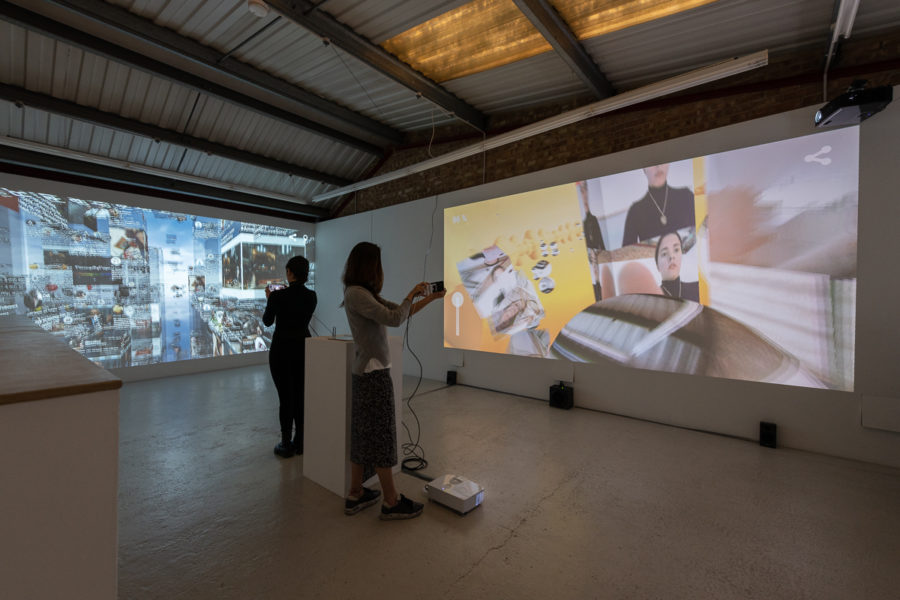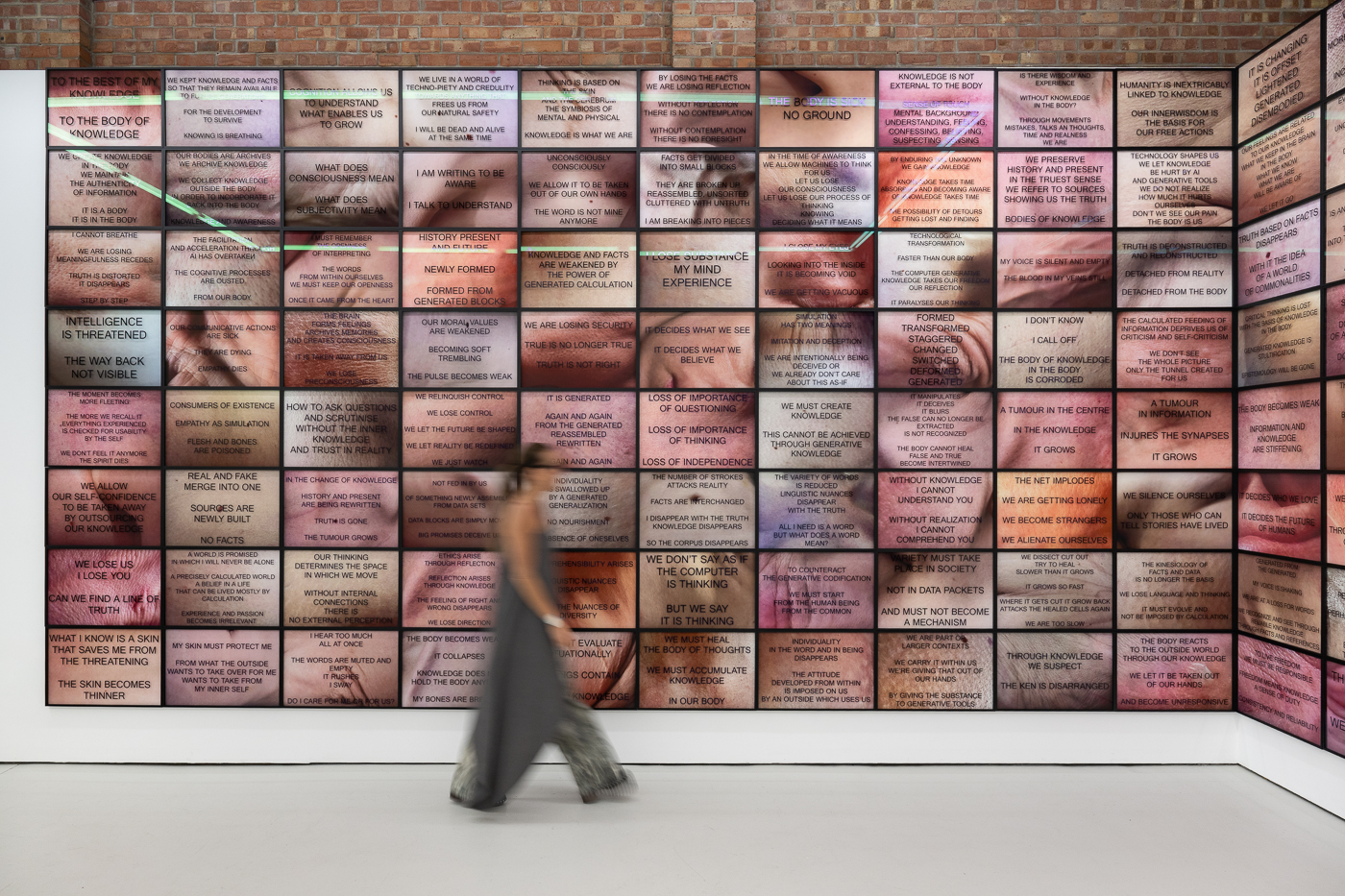
PRESS RELEASE INSTALLATION VIEWS ARTWORKS ARTIST INFORMATION
MARC LEE
26 APRIL — 25 MAY 2019
OPENING RECEPTION
THURSDAY 25 APRIL, 6—8 PM

PRESS RELEASE
Press preview and Performance : Thursday, 25 April, 5 PM
Annka Kultys Gallery is pleased to present Non-Places an augmented reality installation of new bodies of work by the Swiss artist Marc Lee. Shown here for the first time are four interactive works, each using a mobile app as an interface and projected on to the walls of the gallery. The artworks explore how globalization creates “places without a local identity” – as described in Marc Augé’s essay Non-Lieux (1992) – and stimulate a reflective attitude based on a novel “immersive confrontation” with the digital society of our time.
On one wall is projected 10.000 Moving Cities – Same but Different, Mobile App (2018). The work employs a mobile app as interface to create a net-based installation. 10.000 Moving Cities – Same but Different, Mobile App deals with urbanisation and globalisation in the digital age. The app’s user navigates through an urban environment of his choice. The landscape is constantly reshaped and redefined by posts on the social networks Freesound, Instagram and Twitter. Here these personal impressions are streamed in real time like windows to our changing world. The viewer participates in the social movements of our time and makes a virtual journey into constantly new image and sound collages in which one experiences local, cultural and linguistic differences and similarities. In virtual space, this information is visualized on cubes that rise at different heights akin to an urban skyline. As such, the work deals with how our cities are continuously changing and how virtual space is increasingly mimics urban space.
On an adjacent wall is presented a moble app game entitled Me, Myself and I (2018). Me, Myself and I questions egocentrism and narcissism as widespread contemporary phenomena as manifest through their most popular, infamous declination: the selfie culture. The digital era emphasises how individuals perceive themselves increasingly at the centre of, rather than merely being part of, society.
In Me, Myself and I the participant floats virtually in a self-absorbed ego-relationship with herself above an urban, futurist cityscape that is continuously regenerated. The user sees herself rapidly projected into the virtual environment countless times, as another way to replicate over and over again her ego. The virtual environment is entirely dominated by her ego as translated by the selfies the tablet takes, that is, by the many images of the user that populate the cityscape. The virtual environment rotates as the user rotates the device with the sky showing as the tablet is moved upwards, for example. By tilting it downwards the ground appears. At the same time, flight direction can be adjusted, as can the flight speed. The sound is responsive and reacts to the movement and flight speed of the user.
In the exhibition, the image is displayed as one reflective projection, offering a kaleidoscopic view of an urbanised cityscape full of egos. This emphasises the impression of a super star but also allows other visitors to participate.
With the augmented reality app 10.000 Moving Cities – Same but Different, AR (2018) one moves between the imaginary buildings using an iPad and participates in the real time digital communication streams and social movements by means of inserted social media posts. Buildings can be destroyed and rebuilt by the users. But beware! Everyone sees what the other is doing from a different perspective. The more buildings disappear, the more creatures appear… 10.000 Moving Cities – Same but Different, AR focuses on how places are constantly changing, language diversifying, plant and animal species are diminishing and buildings, shopping malls and cities are becoming more and more similar. Places are emerging, which could be anywhere in the world, without a real local identity. This process is accelerated by technological progress, faster means of transport and communication, the internet and augmented reality itself.
Finllay, on tablet, Nonplace (2018) points to the loss of identities through technological progress and globalisation and poses the question of what the ever-growing similarity of cities, shopping centres and commodities means.
Nonplace renders visually and conceptually in virtual reality the concept of ‘Non-places’ which Marc Augé describes in his book and essay of the same name. According to Augé: “Super modernity produces non-places, meaning spaces which are not themselves anthropological spaces and which do not integrate to earlier places … A world where people are born in the clinic and die in hospital, where transit points and temporary abodes are proliferating under luxurious or inhuman conditions (hotel chains and squats, holiday clubs and refugee camps, …; where a dense network of means of transport which are also inhabited spaces is developing; where the habitué of communicates wordlessly, through gestures, with an abstract, unmediated commerce (i.e., credit card transactions); a world thus surrounded by solitary individuality.”
PRESS RELEASE
Marc Lee: Non-Places
INSTALLATION VIEWS










ARTWORKS

10.000 Moving Cites – Same but different, Mobile App
2018
Mobile App as Interface for a Net-Based Installation
Dimensions variable
Edition of 10, 1AP
(MLee002.18)

Me, Myself, and I
2018
Mobile App as Interface for an Interactive Installation
Dimensions variable
Edition of 10, 1AP
(MLee003.18)

Nonplace
2018
Mobile App
Edition of 10, 1 AP
(MLee004.18)

10.000 Moving Cites – Same but different, AR (Augmented Reality)
2018
Mobile App, AR Multiplayer Game Dimensions variable
Edition of 10, 1AP
(MLee001.18)
ARTIST INFORMATION
Marc Lee was born in 1969 in Switzerland where he lives and works.










